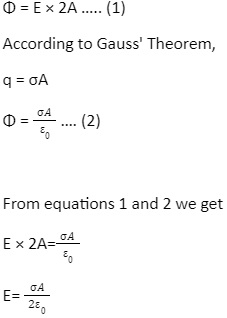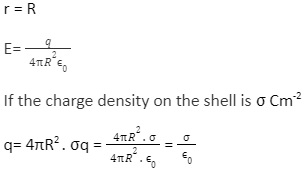The electric field is the most fundamental concept in electricity. In general, the electric field of a surface is calculated using Coulomb’s law, but understanding the concept of Gauss law is required to calculate the electric field due to the infinite sheet. It describes the electric charge enclosed in a closed surface or the electric charge present in a closed surface. We have studied Gauss law previously; according to Gauss’ law, the total electric flux out of a closed surface equals the charge enclosed divided by the permittivity. The electric flux in an area is defined as the electric field multiplied by the surface area projected in a plane perpendicular to the field. Let’s see how we can use Gauss law to calculate electric fields due to an infinite plane sheet of charge.
Electric field due to infinite sheet
In the case of a uniformly charged infinite plane sheet, we consider the plane sheet’s surface charge density. For two-dimensional geometries, the surface charge density is defined as the total charge present per unit area of the plane sheet and is represented by the symbol 𝝈

As a result, the total charge on the plane sheet is σA.
We assume a cylindrical Gaussian surface with cross-sectional area A, length 2r and an axis perpendicular to the plane sheet to calculate the electric field intensity at r distance from the plane sheet. Let S1 and S2 represent the areas of the two circular faces of the cylindrical Gaussian surface and S3 and S4 represent the areas of the two curved faces of the cylindrical Gaussian surface.
Electric flux passing through the cylindrical Gaussian surface can be given as:
Φ = E× area of cross-section of the Gaussian cylinder
The flux due to the electric field of the plane sheet of charge passes only through two circular sections of the cylinder when the electric lines of force are parallel to the curved surface area of the cylinder.

The direction of the electric field due to the infinite sheet is perpendicular to the infinite plane sheet of charge and the nature of the charge is positive.
Electric field due to uniformly charged thin spherical shell
To calculate the total electric field due to uniformly charged thin spherical shell, we will have to divide it into three parts:
Electric field out of the shell
Electric field in the shell
Electric field on the surface of the shell
Electric field out of the shell
Consider the case of a point P located outside the spherical shell, OP = r in this case. The Gaussian surface is assumed to be a sphere with radius r. The intensity of an electric field, E, is said to be the same at every point of a Gaussian surface and is directed outwards.

We can see that the electric intensity at any point outside the spherical shell appears to be concentrated at the shell’s midpoint.
Electric field in the shell
Now, consider the position of point P within the shell. The radius of the Gaussian surface is denoted by r. The Gaussian surface is devoid of any charge.
Hence,
q=0
And from this, we can conclude that the electric field inside the spherical shell always stays zero.
E=0
Electric field on the surface of the shell
As the sphere we have considered is thin, it is safe to assume that the thickness of the shell will be close to negligible.
Therefore- Inner radius = outside radius

Conclusion
The electric flux through an area is calculated by multiplying the electric field by the area of the surface projected in a plane perpendicular to the field. Gauss’ law is a general law that can be applied to any closed surface. It is a useful tool because it allows the amount of enclosed charge to be calculated by mapping the field on a surface outside the charge distribution. It simplifies the calculation of the electric field for sufficiently symmetric geometries as we saw how it helped us in the calculation of electric field due to the infinite sheet and on a uniformly charged thin spherical shell.
 Profile
Profile Settings
Settings Refer your friends
Refer your friends Sign out
Sign out






